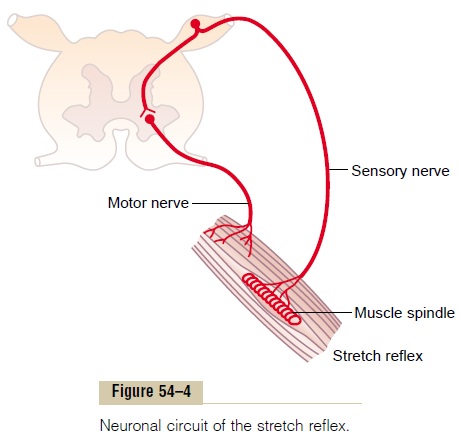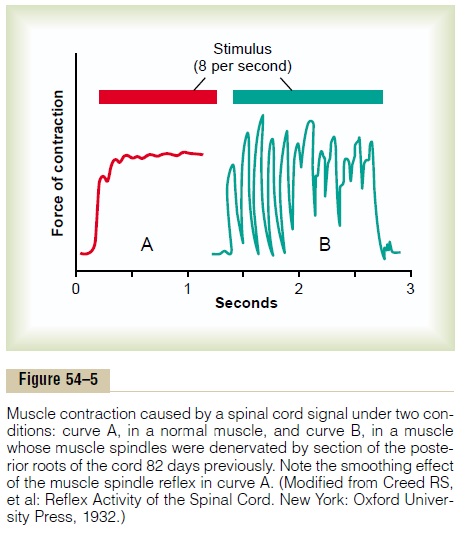Chapter: Medical Physiology: Motor Functions of the Spinal Cord; the Cord Reflexes
Role of the Muscle Spindle in Voluntary Motor Activity
Role of the Muscle Spindle in Voluntary Motor Activity
To emphasize the importance of the gamma efferent system, one needs to recognize that 31 per cent of all the motor nerve fibers to the muscle are the small type A gamma efferent fibers rather than large type A alpha motor fibers. Whenever signals are transmitted from the motor cortex or from any other area of the brain to the alpha motor neurons, in most instances the gamma motor neurons are stimulated simultaneously, an effect called coactivation of the alpha and gamma motor neurons. This causes both the extrafusal skele-tal muscle fibers and the muscle spindle intrafusal muscle fibers to contract at the same time.
The purpose of contracting the muscle spindle intra-fusal fibers at the same time that the large skeletal muscle fibers contract is twofold: First, it keeps the length of the receptor portion of the muscle spindle from changing during the course of the whole muscle contraction. Therefore, coactivation keeps the muscle spindle reflex from opposing the muscle contraction. Second, it maintains the proper damping function of the muscle spindle, regardless of any change in muscle length. For instance, if the muscle spindle did not con-tract and relax along with the large muscle fibers, the receptor portion of the spindle would sometimes be flail and sometimes be overstretched, in neither instance operating under optimal conditions for spindle function.
Brain Areas for Control of the Gamma Motor System
The gamma efferent system is excited specifically by signals from the bulboreticular facilitatory region of the brain stem and, secondarily, by impulses transmit-ted into the bulboreticular area from (1) the cerebel-lum, (2) the basal ganglia, and (3) the cerebral cortex.
Little is known about the precise mechanisms of control of the gamma efferent system. However, because the bulboreticular facilitatory area is par-ticularly concerned with antigravity contractions, and because the antigravity muscles have an especially high density of muscle spindles, emphasis is given to the importance of the gamma efferent mechanism for damping the movements of the different body parts during walking and running.
Muscle Spindle System Stabilizes Body Position During Tense Action
One of the most important functions of the muscle spindle system is to stabilize body position during tense motor action. To do this, the bulboreticular facil-itatory region and its allied areas of the brain stem transmit excitatory signals through the gamma nerve fibers to the intrafusal muscle fibers of the muscle spindles. This shortens the ends of the spindles and stretches the central receptor regions, thus increasing their signal output. However, if the spindles on both sides of each joint are activated at the same time, reflex excitation of the skeletal muscles on both sides of the joint also increases, producing tight, tense muscles opposing each other at the joint. The net effect is that the position of the joint becomes strongly stabilized, and any force that tends to move the joint from its current position is opposed by highly sensitized stretch reflexes operating on both sides of the joint.
Any time a person must perform a muscle function that requires a high degree of delicate and exact posi-tioning, excitation of the appropriate muscle spindles by signals from the bulboreticular facilitatory region of the brain stem stabilizes the positions of the major joints. This aids tremendously in performing the additional detailed voluntary movements (of fingers or other body parts) required for intricate motor procedures.


Related Topics